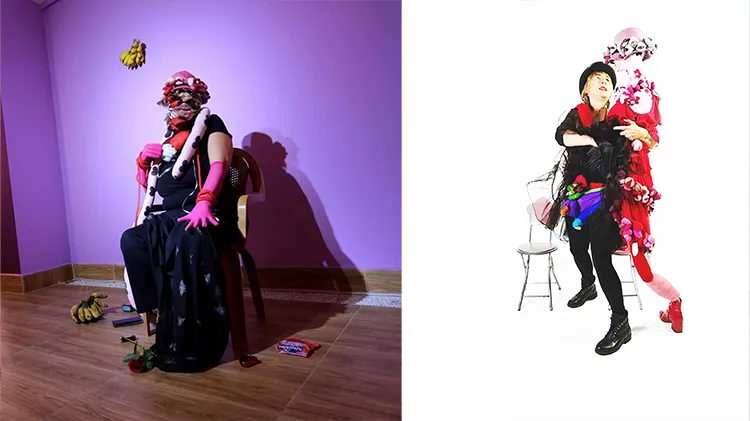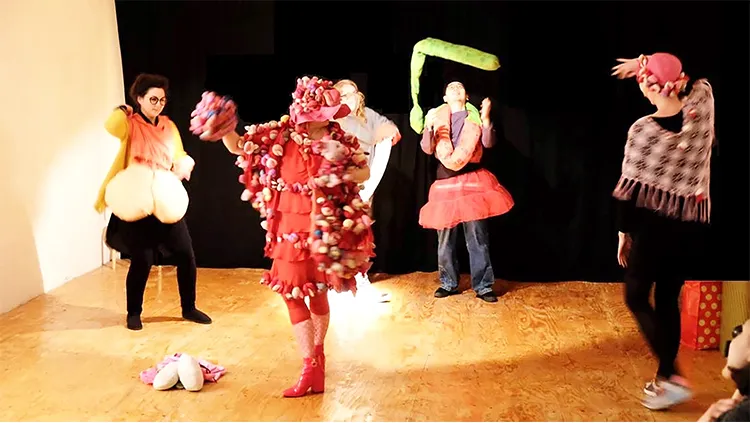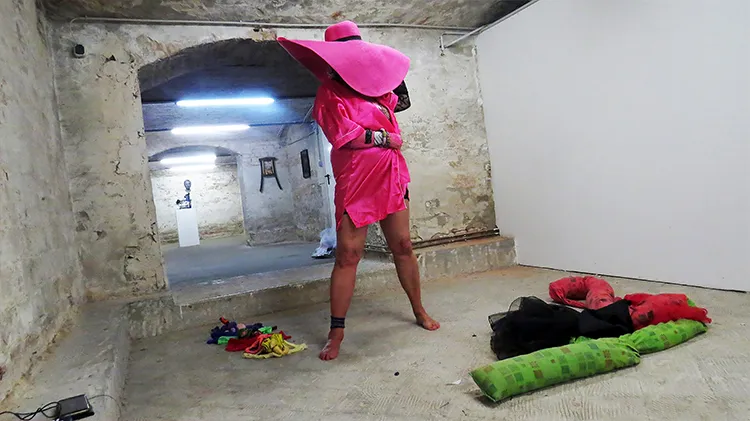Banner image credits: Dipa Mahbuba Yasmin
“I need this spirit of revolution in my art. I feel bad if everything around me is consistent and sweet.”
A Visionary Beyond Boundaries: The Unconventional Journey of Alexandra Holownia
Alexandra Holownia, widely known as “Fly,” is a visual artist and performer whose creative journey has taken her from the great stages of Berlin, Paris, London, and Miami to the streets of Africa, India, and Bangladesh. Her performances are striking, often built around elaborate costumes and props, each crafted to challenge the audience’s perceptions. She draws inspiration from an eclectic mix of personal experiences, improvisation, and a desire to engage with new environments, pushing herself into unknown territories where spontaneity reigns. The diverse venues in which she has performed—from art fairs to bustling city streets—require her to adapt quickly, an ability she has honed over many years.
Fly’s performances are both a statement and an exploration. Preferring neutral, closed spaces for the intimate control they provide, she nevertheless relishes the unpredictability of public performances. These outdoor sessions force her to engage with audiences who are often unfamiliar with the avant-garde nature of her art. The reactions, ranging from confusion to admiration, feed into her evolving practice. From her beginnings in 2007 as Alexandra Fly, with costumes that boldly mimic the vulva, to playing iconic art events like FIAC in Paris, Fly’s artistic journey has been defined by both provocation and an embrace of artistic freedom.
A particularly vivid moment in her career occurred at Paris’s Palais de Tokyo, where her striking costume earned her the favor of the museum’s liberal director. Conversely, at the Louvre, her attire prompted a challenge from security, eventually allowing her entry under stringent conditions. These contrasting experiences illustrate the power of her presence and her insistence on pushing cultural boundaries within traditional art institutions.

Photo credits: Dipa Mahbuba Yasmin (left), Waldemar Kremser (right)
Dancing with Diversity and Surreal Sculptures
From 2016 to 2019, Alexandra Holownia’s career flourished with a string of performances at prestigious festivals across Europe and the United States. Her participation in events in Italy, the Netherlands, Poland, the Czech Republic, Belgium, Miami, and Cyprus was marked by her unique piece, “Alexandra Fly Dance.” This performance invited audience members to interact with her sculptures and costumes, immersing themselves in a direct, participatory experience. Through this piece, Holownia aimed to promote tolerance for diversity and break down taboos surrounding the human body. Reflecting on her travels, she remarked on the openness of audiences in places like Miami, the Netherlands, and Cyprus, where viewers enthusiastically engaged with her costumes, transforming the performance into a collaborative experience.
English audiences also captured Holownia’s admiration, particularly for their wit and readiness to embrace art that pushes boundaries. The interactive costumes used in Alexandra Fly Dance originated from her early work on Ulysses and were designed not only for visual impact but also for direct audience engagement. This idea of incorporating costumes as sculptures was revolutionary at the time, as she invited the public to wear and interact with her creations. By merging art and audience, Holownia transcended traditional boundaries, fostering an environment where participants were not just observers but contributors to the performance’s fluid, evolving narrative.
Her departure from traditional sculptural materials such as stone and metal into softer, more flexible fabrics was a defining feature of her work. These lightweight, touchable materials could be shaped, worn, and manipulated, allowing for the creation of surreal characters that challenged perceptions of identity and form. The music in Alexandra Fly Dance added another layer of complexity; initially, Holownia collaborated with Polish composer Bogdan Mizerski, whose Dadaist compositions mirrored the abstract nature of her performance. In 2019, she partnered with French composer Anne Germanique, whose experimental sound art seamlessly complements the avant-garde energy of Holownia’s pieces. Occasionally, German guitarist Ernst Joachim Cziesla also joined her, adding a dynamic musical element to her performances.
Costume design remains central to Holownia’s work, as she meticulously crafts each piece to align with her artistic vision. Her costumes and props are integral to the narratives she presents, with every stitch and fabric choice contributing to the depth and meaning of her performances. Holownia’s creations are more than just visual spectacles—they serve as vessels for her themes, reinforcing the provocative and thought-provoking nature of her art. By controlling every aspect of the visual and performative experience, she ensures that her work is a holistic reflection of her bold, unflinching artistic statements.

Photo credits: Luke Jordan
Alexandra Holownia: Breaking Free from Traditional Artistry
The driving force behind Fly’s transition into the world of performance art was a disdain for the constraints of conventional theater. In Poland, she found her voice in the of-theater movement, allowing her to cultivate her creative expression outside institutional boundaries. She was particularly influenced by workshops led by Rena Mirecka at the Wroclaw Laboratory Theater, as well as her experiences with the Gardzienice Theater Practices, known for their radical experimentation. It was during this period of exploration that Fly began incorporating her own costume designs into theatrical performances.
In 1984, Fly found herself collaborating with the Pantomime Studio Kineo Theater, where her costume designs were featured in a production of James Joyce’s Ulysses. Though this initial attempt to blend her vision into conventional theater was met with mixed success, it marked a critical turning point in her career. Realizing that her true calling lay in the immediacy of live performance rather than traditional settings, she began creating short pieces for galleries, establishing herself as a solo performer. The freedom of this medium allowed her to craft powerful, spontaneous stories that spoke directly to her audience.
Throughout the late 1980s and beyond, Fly began developing her own brand of visual and experimental art within the framework of theater, both as part of ensembles and on her own. Performances like Transformation and Annihilation, which were showcased at festivals such as the Kassel City Culture Festival, allowed her to present work that was visually arresting and conceptually daring. Returning to the stage in 2016, Fly brought her unique blend of storytelling, costuming, and performance to audiences at iconic venues like Zurich’s Voltaire Cabaret.

Photo credits: Roland Ball
Weaving Feminism into Fabric and Performance
Fly’s artistic style revolves around costumes and props, often sewn by herself from found materials, including discarded scraps she gathered during an artistic residency in Ghana. Her work transcends the visual, deeply integrating her feminist beliefs into each piece. Through her performances, Fly directly confronts social taboos and challenges patriarchal narratives, focusing on issues ranging from bodily autonomy to gender equality. These themes are not just abstract ideas for her—they are manifest in the very costumes she wears, such as her notorious red or pink outfits adorned with elements resembling the vulva, which have both provoked and captivated audiences for years.
The thematic content of Fly’s work explores a wide spectrum of feminist issues, such as forced marriage, ritual circumcision, and age-based discrimination. Her pieces often feature elements of provocation, aimed at exposing the discomfort society feels towards open discussions of female anatomy and sexuality. In 2023, Fly further expanded her impact by founding “Woman’s World” at the Pandora Gallery in Berlin, an international performance art event focused on women’s rights. Through this initiative, she aims to foster collaboration among artists who share her vision for social justice and the breaking of taboos, seeking to create an ongoing dialogue that transcends geographic and cultural boundaries.
Beyond feminist themes, Fly’s work also addresses topics related to freedom, diversity, and the rights of the LGBTQ+ community. The essence of her performance art lies in storytelling—a practice she manages through careful scriptwriting, ensuring that each narrative is delivered with precision and emotional depth. Whether addressing the pressures of cosmetic surgery or celebrating gender diversity, her work is designed to provoke thought and spark conversation, encouraging audiences to reconsider their assumptions about gender, identity, and power.

Photo credits: Chang Chen (left), Spike Mclarrity (right)
Alexandra Holownia: The Legacy of Soft Sculptures and Rebellious Inspiration
One of Fly’s most treasured works remains her diploma project from the 1982 Stage Design Studio in Warsaw—a series of costume sculptures for Ulysses. These pieces, crafted from colorful flax and filled with lightweight materials, represent various parts of the human body, such as the eyes, lips, and even genitalia. These costume sculptures are worn by performers, transforming their bodies into surreal forms that challenge traditional representations of the human figure. This concept of deforming and reshaping the body through costume has been a recurring element in her career, appearing in numerous performances, including Alexandra Fly Dance, in which audience members are invited to don these whimsical garments.
The provocative nature of her work has often led to controversy. Her exhibition of the Ulysses costume sculptures in Poznań in 1984 was abruptly canceled due to concerns about exposing children to the “immorality” of her work. This reaction only solidified Fly’s belief in the power of her art to unsettle and provoke—a quality she has embraced wholeheartedly. Decades later, her performance as “Mrs. Vagina on the Road” continued to challenge societal norms, utilizing fabric costumes designed to represent the vulva, thus extending the themes she began exploring in the 1980s.
Fly’s artistic influences are varied and profound. Her mentor, Józef Szajna, was instrumental in shaping her perspective on the role of visual elements in theater, inspiring her to transform performers into “surreal visual objects.” Jerzy Piotrowicz, a painter from Poznań, further inspired Fly with his rebellious spirit, encouraging her to use art as a vehicle for questioning societal norms. Meeting Louise Bourgeois in the mid-1990s had a particularly deep impact on Fly, especially Bourgeois’s use of soft sculptures and her exploration of themes related to the patriarchy. Fly also draws inspiration from British artist Sarah Lucas, whose erotic sculptures resonate with Fly’s approach to art as a means of personal and political expression.






